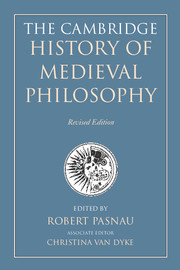Book contents
- Frontmatter
- Contents of Volume 1
- Preface
- List of contributors
- Frontmatter
- Contents of Volume 2
- Introduction
- I Fundamentals
- II Logic and language
- III Natural philosophy
- IV Soul and knowledge
- 21 Soul and body
- 22 The soul’s faculties
- 23 The nature of intellect
- 24 Perception
- 25 Mental representation
- 26 Science and certainty
- 27 Divine illumination
- 28 Skepticism
- V Will and desire
- VI Ethics
- VII Political philosophy
- VIII Metaphysics
- IX Theology
- Appendices
- Bibliography of primary sources
- Bibliography of secondary sources
- Index nominum
- Index rerum
- References
27 - Divine illumination
from IV - Soul and knowledge
Published online by Cambridge University Press: 05 August 2014
- Frontmatter
- Contents of Volume 1
- Preface
- List of contributors
- Frontmatter
- Contents of Volume 2
- Introduction
- I Fundamentals
- II Logic and language
- III Natural philosophy
- IV Soul and knowledge
- 21 Soul and body
- 22 The soul’s faculties
- 23 The nature of intellect
- 24 Perception
- 25 Mental representation
- 26 Science and certainty
- 27 Divine illumination
- 28 Skepticism
- V Will and desire
- VI Ethics
- VII Political philosophy
- VIII Metaphysics
- IX Theology
- Appendices
- Bibliography of primary sources
- Bibliography of secondary sources
- Index nominum
- Index rerum
- References
Summary
Illumination has an intriguingly complex history, which could be approached in many different ways. One could trace the philosophical evolution of the theme of light as a metaphor for understanding intellectual cognition, in which case our treatment would have to commence with the discussion of intellectual cognition among the major figures in Greek philosophy, especially Plato and Aristotle, both of whom regularly employed the metaphor of light in their efforts at grappling with the mysterious nature of intellectual cognition. Alternatively, one could focus on theories of human intellectual cognition that appeal to intellects higher than ours but still not divine to account for how human intellectual activities are possible. But the object of the present chapter, more narrowly still, is to trace out the theory of divine illumination – that is, the theory of how God’s light is required to account fully for how humans are capable of attaining the truth that they manage to attain through their intellectual activities. Considered in this way, the philosophical story we shall trace begins with Augustine, though the figures we shall be focused upon mainly are thirteenth-century philosophers. The reason for targeting thirteenth-century figures is that, although the texts of Augustine that inspire the theory were well known throughout the Middle Ages, it was only in the late twelfth and early thirteenth centuries that philosophers writing in Latin began to perceive, largely through their acquaintance with the recently translated Arabic sources and translations of Aristotle, that an alternative approach to that of Augustine was a genuinely viable option. Hence, prior to the thirteenth century, one might speak of the theme of divine illumination, but not a theory of divine illumination.
- Type
- Chapter
- Information
- The Cambridge History of Medieval Philosophy , pp. 369 - 383Publisher: Cambridge University PressPrint publication year: 2014



